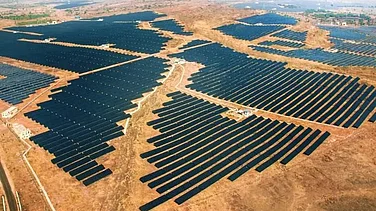In a climate of growing global anxiety over coal, India finds itself walking a tightrope, between its renewable ambitions and the pressing need to power its fast-growing economy. The paradox highlights a seemingly intractable fast-growing developing country challenge: securing a low-carbon future, while addressing immediate economic imperatives.
Nothing illustrates the dilemma more starkly than the country’s economic strategy, which is founded on promoting renewable energy without easing up on coal to fuel its economic engine, at least for the medium term. For a sense of how incredibly challenging the road to transition is - consider these facts. To fulfil its pledge at 2021 UN Climate Summit in Glasgow, India needs to boost its non-fossil fuel capacity to 500 GW and meet 50 per cent of its energy needs with renewables by 2030. And yet, as we head into 2025, coal remains the mainstay of its energy mix, accounting for 70 per cent of all the power it produces.
The Coal Conundrum
India’s continued dependence on the fossil fuel is largely due to its vital role in powering industries critical to economic expansion. For all its notoriety, coal offers several incomparable advantages that emerging economies like India simply cannot abandon - its abundant availability and low cost being the two most striking. Transitioning from it, therefore, presents a gauntlet of logistical, financial, and infrastructural challenges.
Coal-fired power plants, for instance, produce electricity continuously, making them ideal for meeting base load demand. Until energy storage systems and grid-stabilising solutions are widely adopted, coal will, therefore, remain the fuel of choice to ensure India’s electricity supply stays stable.
The Union Power Minister Manohar Lal Khattar acknowledged as much in his September media briefing. “India’s peak power demand is projected to reach 458 GW by 2032 far outstripping the supply of green power and so we would have continue investing in coal projects until 2035,” the minister said. Experts believe India’s reliance on coal will persist for at least a couple of decades more. In this time, the key to managing the energy portfolio will lie in blending renewables into the mix while exploring alternative methods to keep energy costs low.
A Renewable Energy Push
Echoing this assessment, the International Energy Agency (IEA), in its World Energy Outlook report, asserted that coal will continue to dominate India’s energy mix in the coming decades with an expected net addition of 60 GW by 2030. “Though solar capacity is set to double over the next decade, coal-generated power will still surpass solar PV by 30% due to the latter's lower capacity factor,” the report stated. Furthermore, it pointed out that coal met 40 per cent of the energy demand of India’s industrial sector in 2023, a figure set to reach 50 per cent by 2035, highlighting its vital role in keeping the country’s economy on track.
However, recognising that it cannot fall up on its climate commitments even as it persists with coal, the government has launched a slew of ambitious renewable energy initiatives, backed by massive investment of Rs 16.93 trillion since 2014. This investment includes Rs 11.2 trillion in sectors like generation, distribution and transmission while Rs 5.73 trillion in renewable energy sector. However, scaling these efforts to meet the country’s enormous energy demands requires overcoming several daunting hurdles, including inadequate infrastructure, high initial costs, and the need for breakthrough technologies.
Regardless of how overwhelming the dilemma is, however, India has no choice but to continue promoting renewables with unflagging energy.
Rishab Kohli, Managing Director of ADM Orient Solar, points out that the biggest barriers to expanding solar energy are the lack of suitable land and the need for ground-breaking solutions in storage and conversion systems, particularly in inverter and battery technology and manufacturing. The only way is to accelerate innovation across the renewable ecosystem, say experts. This includes advancing energy storage technologies, strengthening transmission infrastructure, and implementing smart grid solutions to optimise power distribution and consumption.
China’s journey provides valuable insights into scaling up domestic manufacturing capabilities. Its systematic approach to building robust supply chains and production ecosystems demonstrates what’s possible with focused execution. India can adapt these lessons while leveraging its geographical and demographic advantages in the renewable sector.
“The key isn't to replicate other nations' paths, but to craft an Indian solution to an Indian challenge. Our focus must be on maximising the efficiency of renewable installations—through improved technology, better forecasting, and strategic geographical placement. At the same time, we must accelerate the development of alternative green measures and storage solutions to significantly reduce the projected capacity gap,” said Sanjay Gupta, Chief Executive Officer of Apollo Green Energy.
Exploring Alternative Sources
Nuclear energy, particularly in the form of Small Modular Nuclear Reactors offers more than just baseload power; it promises energy security with minimal carbon impact. As technology evolves, it unlocks new possibilities for safer and more cost-effective solutions.
Offshore wind energy is another promising opportunity. India’s extensive coastline provides access to consistent and powerful wind resources capable of generating substantial amounts of electricity. “Offshore wind farms can be a stable, high-output energy source, helping to balance intermittent renewables like solar and onshore wind,” says Naresh Mansukhani, CEO of Juniper Green Energy.
To bridge the gap between fossil fuels and renewables, India must deploy a diversified mix of alternative energy solutions that bolster the renewable energy system. Green hydrogen, produced using renewable resources, holds significant potential for decarbonising hard-to-abate sectors like heavy industries and transportation.
Charith Konda, Energy Specialist at the Institute for Energy Economics and Financial Analysis (IEEFA), notes that other countries benefit from substantial natural gas reserves and nuclear power, enabling them to reduce reliance on coal. India lags on this front. “Can we increase hydropower to meet incremental demand at a higher rate? Perhaps not, as hydropower is constrained by the availability of suitable sites. But certainly solar, wind, and nuclear energy, are viable alternatives,” he says.
Striking The Right Balance
India’s energy dilemma underscores the complex challenge of balancing its growing energy demand with its global climate commitments. The interplay between India’s 213.7 GW renewable capacity and coal imports reveals a stark truth: the real challenge is not coal-dependence, but the readiness of infrastructure to facilitate a complete transition. This is not about choosing between coal and renewables; the current energy landscape demands an integrated approach where both coexist as crucial parts of a balanced energy ecosystem.
The focus must be on systematic transformation—building robust grids, scaling storage solutions, and developing hybrid systems. The aim is not the immediate elimination of coal but an intelligent transition that ensures both energy security and environmental sustainability. How India navigates this dilemma will not only shape its energy future but also have a significant impact on the Global South.






_1640920638.jpg?w=801&auto=format%2Ccompress&fit=max&format=webp&dpr=1.0)




















